RBSE Solutions for Class 6 Maths Chapter 4 Basic Geometrical Ideas Ex 4.1
Rajasthan Board RBSE Solutions for Class 6 Maths Chapter 4 Basic Geometrical Ideas Ex 4.1 Textbook Exercise Questions and Answers.
Rajasthan Board RBSE Solutions for Class 6 Maths in Hindi Medium & English Medium are part of RBSE Solutions for Class 6. Students can also read RBSE Class 6 Maths Important Questions for exam preparation. Students can also go through RBSE Class 6 Maths Notes to understand and remember the concepts easily. Students are advised to practice अनुपात और समानुपात के प्रश्न class 6 of the textbook questions.
RBSE Class 6 Maths Solutions Chapter 4 Basic Geometrical Ideas Ex 4.1
Question 1.
Use the figure to name:
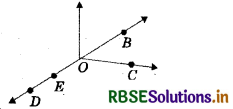
(a) Five points
Answer:
Five points : O, B, C, D, E

(b) A line
Answer:
A line: \(\overleftrightarrow{D E}, \overleftrightarrow{D B}, \overleftrightarrow{O E}, \overleftrightarrow{O B}\)
(c) Four rays
Answer:
Four rays: \(\overrightarrow{O D}, \overrightarrow{O E}, \overrightarrow{O C}, \overrightarrow{O B}\)
(d) Five line segments
Answer:
Five line segments: \(\overline{D E}, \overline{D O}, \overline{E O}, \overline{O B}, \overline{E B}\), etc.

Question 2.
Name the line given in all possible (twelve) ways, choosing only two letters at a time from the four given:

Answer:

Question 3.
Use the figure to name :
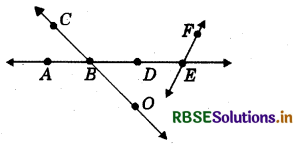
(a) Line containing point E,
Answer:
Line containing point E = \(\overleftrightarrow{A E}, \overleftrightarrow{F E}\)
(b) Line passing through A,
Answer:
Line passing through A = \(\overleftrightarrow{A E}, \overleftrightarrow{D E}\)

(c) Line on 'which O lies,
Answer:
Line on which 0 lies = \(\overleftrightarrow{C O}, \overleftrightarrow{B O}\)
(d) Two pairs of intersecting lines.
Answer:
Two pairs of intersecting lines are \(\overleftrightarrow{A D}, \overleftrightarrow{C O}\) and \(\overleftrightarrow{A E}, \overleftrightarrow{F E}\).
Question 4.
How many lines can pass through
(a) one given point?
(b) two given points?
Answer:
(a) Infinite number of lines can pass through one given point.


(b) Only one line can pass through two given points.

Question 5.
Draw a rough figure and label suitably in each of the following cases:
(a) Point P lies on \(\overleftrightarrow{A B}\),
Answer:
Point P lies on \(\overleftrightarrow{A B}\),

(b) \(\overleftrightarrow{X Y}\) and \(\overleftrightarrow{P Q}\) intersect at M,
Answer:
\(\overleftrightarrow{X Y}\) and \(\overleftrightarrow{P Q}\) intersect at M,
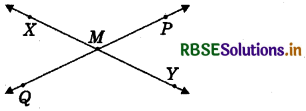
(c) Line l contains E and F but not D,
Answer:
Line l contains E and F but not D,
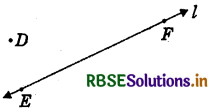

(d) \(\overleftrightarrow{O P}\) and \(\overleftrightarrow{O Q}\) meet at O.
Answer:
\(\overleftrightarrow{O P}\) and \(\overleftrightarrow{O Q}\) meet at O.
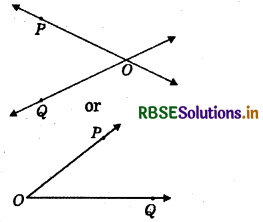
Question 6.
Consider the following figure of line \(\overleftrightarrow{M N}\). Say whether following statements are true or false in context of the given figure:
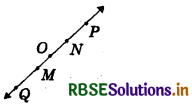
(a) Q, M, O, N, P are points on the line \(\overleftrightarrow{M N}\).
Answer:
True
(b) M, O, N are points on a line segment \(\overline{M N}\).
Answer:
True

(c) M and N are end points of line segment \(\overline{M N}\).
Answer:
True
(d) O and N are end points of line segment \(\overline{O P}\).
Answer:
False
(e) M is one of the end points of line segment \(\overline{Q O}\).
Answer:
False
(f) M is point on ray \(\overrightarrow{O P}\).
Answer:
False
(g) Ray \(\overrightarrow{O P}\) is different from ray \(\overrightarrow{Q P}\).
Answer:
True

(h) Ray \(\overrightarrow{O P}\) is same as ray \(\overrightarrow{O M}\).
Answer:
False
(i) Ray \(\overrightarrow{O M}\) is not opposite to ray \(\overrightarrow{O P}\).
Answer:
False
(j) O is not an initial point of \(\overrightarrow{O P}\).
Answer:
False
(k) N is the initial point of \(\overrightarrow{N P}\) and \(\overrightarrow{N M}\).
Answer:
True

- RBSE Solutions for Class 6 Maths Chapter 2 Whole Numbers InText Questions
- RBSE Class 6 Maths Important Questions Chapter 1 अपनी संख्याओं की जानकारी
- RBSE Solutions for Class 6 Maths Chapter 7 भिन्न Intext Questions
- RBSE Solutions for Class 6 Maths Chapter 7 Fractions Ex 7.4
- RBSE Solutions for Class 6 Maths Chapter 1 Knowing our Numbers Ex 1.1
- RBSE Solutions for Class 6 Maths Chapter 1 Knowing our Numbers InText Questions
- RBSE Solutions for Class 6 Maths in Hindi Medium & English Medium
- RBSE Solutions for Class 6 Maths Chapter 7 Fractions InText Questions
- RBSE Solutions for Class 6 Maths Chapter 7 Fractions Ex 7.6
- RBSE Solutions for Class 6 Maths Chapter 7 Fractions Ex 7.5
- RBSE Solutions for Class 6 Maths Chapter 7 Fractions Ex 7.3